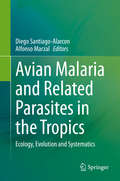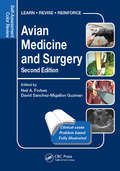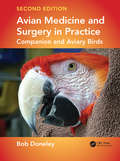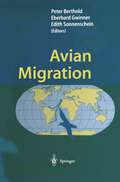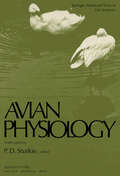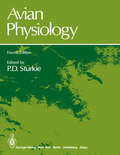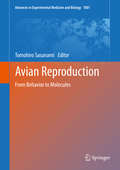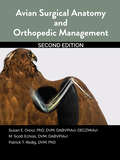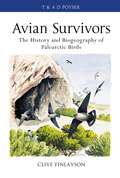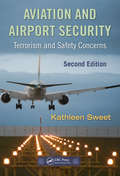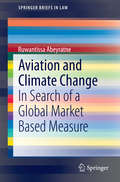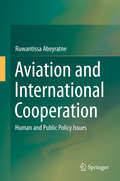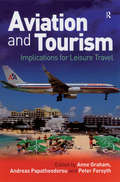- Table View
- List View
Avian Malaria and Related Parasites in the Tropics: Ecology, Evolution and Systematics
by Diego Santiago-Alarcon Alfonso MarzalThe Tropics are home to the greatest biodiversity in the world, but tropical species are at risk due to anthropogenic activities, mainly land use change, habitat loss, invasive species, and pathogens. Over the past 20 years, the avian malaria and related parasites (Order: Haemosporida) systems have received increased attention in the tropical regions from a diverse array of research perspectives. However, to date no attempts have been made to synthesize the available information and to propose new lines of research. This book provides such a synthesis by not only focusing on the antagonistic interactions, but also by providing conceptual chapters on topics going from avian haemosporidians life cycles and study techniques, to chapters addressing current concepts on ecology and evolution. For example, a chapter synthesizing basic biogeography and ecological niche model concepts is presented, followed by one on the island biogeography of avian haemosporidians. Accordingly, researchers and professionals interested in these antagonistic interaction systems will find both an overview of the field with special emphasis on the tropics, and access to the necessary conceptual framework for various topics in ecology, evolution and systematics. Given its conceptual perspective, the book will appeal not only to readers interested in avian haemosporidians, but also to those more generally interested in the ecology, evolution and systematics of host-parasite interactions.
Avian Medicine
by Jaime SamourCombining the in-depth coverage of a text with the practicality of a clinical manual and the visual detail of an atlas, Avian Medicine, 3rd Edition is the complete, all-in-one guide to every aspect of avian care. Written by some of the world's leading authorities in avian medicine, this highly illustrated reference covers a wide variety of avian species — including psittacines, raptors, bustards, parrots, finches, and more. Comprehensive coverage includes issues ranging from the basic aspects of patient management to the most sophisticated diagnostic techniques. Plus, with more illustrations, a wealth of practical advice, and the latest information on cutting-edge treatments and procedures incorporated into this new edition, today's general clinician will be fully equipped to effectively and confidently care for all birds. - Comprehensive coverage of all aspects of clinical management written by leading experts in the field provides readers with a depth and breadth of knowledge on avian medicine and care. - Coverage of a wide variety of species — including raptors, bustards, and many others — enables practitioners to treat a greater assortment of patients with more confidence and skill. - Bulleted text and tables help present information in an accessible way. - More than 900 color images give readers a better picture of disease and how it will be encountered in practice. - Appendices bring together wide-ranging data on hematology and blood chemistry reference values, commonly used pharmaceutics and other information relevant to avian practitioners. - NEW! New chapter sections, revised references, and updated suggested readings ensure that readers have the most up-to-date information. - NEW! New chapter contributors ensure the information in the text reflects the most current techniques and advances. - NEW! Expanded content on parrots, finches and fruit-eating birds has been added to the text to make content more relevant to the needs of today's practitioners. - NEW! Thoroughly updated content includes the latest surgical techniques and procedures to keep practitioners on top of the most cutting-edge information in the field. - NEW! Additional content and images on MRI have been incorporated throughout the text to complete the coverage of other advanced imaging techniques such as CT scans.
Avian Medicine and Surgery: Self-Assessment Color Review, Second Edition (Veterinary Self-Assessment Color Review Series)
by Neil A. Forbes David Sanchez-Migallon GuzmanThis completely revamped second edition of Avian Medicine and Surgery includes over 260 all-new colour illustrated cases, with questions and answers fully exploring a breadth of diseases and disorders. Avian patients are a routine part of the veterinary case load and are being seen by many clinicians across the world. This book provides a unique quick reference for clinicians and a useful self-test for students by offering comprehensive, clinically-oriented information that can be quickly accessed, easily understood and applied. With contributions from leading international authorities with diverse fields of expertise, the book covers a wide range of disciplines, organ systems and species. The cases are presented in a random order, just as they would appear in daily practice, challenging the reader to address real clinical situation and offering, where possible, a comprehensive solution.
Avian Medicine and Surgery: Self-Assessment Color Review, Second Edition (Veterinary Self-Assessment Color Review Series)
by Neil A. Forbes David Sanchez-Migallon GuzmanThis completely revamped second edition of Avian Medicine and Surgery includes over 260 all-new colour illustrated cases, with questions and answers fully exploring a breadth of diseases and disorders. Avian patients are a routine part of the veterinary case load and are being seen by many clinicians across the world. This book provides a unique quick reference for clinicians and a useful self-test for students by offering comprehensive, clinically-oriented information that can be quickly accessed, easily understood and applied. With contributions from leading international authorities with diverse fields of expertise, the book covers a wide range of disciplines, organ systems and species. The cases are presented in a random order, just as they would appear in daily practice, challenging the reader to address real clinical situation and offering, where possible, a comprehensive solution.
Avian Medicine and Surgery in Practice: Companion and Aviary Birds, Second Edition
by Bob DoneleyAvian Medicine and Surgery in Practice is an invaluable quick reference resource for clinicians and a useful study guide for veterinary students. In this practical and beautifully illustrated book, early chapters cover physical examination, advice on interpreting diagnostic tests, and avian anatomy and physiology. Disorders affecting the different body regions and systems make up the majority of the book from the external—skin, feathers, eyes, legs and feet—to the internal including the gastrointestinal tract and the cardiovascular system. Further aspects of avian medicine discussed in the book include behavioural problems, incubation of eggs, paediatrics and surgery. Written by an expert with more than 30 years of clinical experience in avian medicine, the new edition is thoroughly revised with updated diseases, new and expanded clinical techniques, and over 100 new color illustrations. It also adds four important new chapters: Husbandry, Grooming and Nutrition, Diagnostic Imaging, Endoscopy, and Oncology as well as new sections on cardiovascular anatomy and neuroanatomy.
Avian Medicine and Surgery in Practice: Companion and Aviary Birds, Second Edition (Manson Ser.)
by Bob DoneleyAvian Medicine and Surgery in Practice is an invaluable quick reference resource for clinicians and a useful study guide for veterinary students. In this practical and beautifully illustrated book, early chapters cover physical examination, advice on interpreting diagnostic tests, and avian anatomy and physiology. Disorders affecting the different body regions and systems make up the majority of the book from the external—skin, feathers, eyes, legs and feet—to the internal including the gastrointestinal tract and the cardiovascular system. Further aspects of avian medicine discussed in the book include behavioural problems, incubation of eggs, paediatrics and surgery. Written by an expert with more than 30 years of clinical experience in avian medicine, the new edition is thoroughly revised with updated diseases, new and expanded clinical techniques, and over 100 new color illustrations. It also adds four important new chapters: Husbandry, Grooming and Nutrition, Diagnostic Imaging, Endoscopy, and Oncology as well as new sections on cardiovascular anatomy and neuroanatomy.
Avian Migration
by Peter Berthold Eberhard Gwinner Edith SonnenscheinP. Berthold and E. Gwinnd Bird migration is an intriguing aspect of the living world - so much so that it has been investigated for as long, and as thoroughly, as almost any other natural phenomenon. Aristotle, who can count as the founder of scientific ornithology, paid very close attention to the migrations of the birds he ob served, but it was not until the reign of Friedrich II, in the first half of the 13th century, that reliable data began to be obtained. From then on, the data base grew rapidly. Systematic studies of bird migration were introduced when the Vogelwarte Rossitten was founded, as the first ornithological biological observation station in the world (see first chapter "In Memory of Vogelwarte Rossitten"). This area later received enormous impetus when ex perimental research on the subject was begun: the large-scale bird-ringing experiment initiated in Rossitten in 1903 by Johannes Thienemann (who was inspired by the pioneering studies of C. C. M. Mortensen), the experiments on photoperiodicity carried out by William Rowan in the 1920s in Canada and retention and release experiments performed by Thienemann in the 1930s in Rossitten, the first experimental study on the orientation of migratory birds. After the Second World War, migration research, while continuing in the previous areas, also expanded into new directions such as radar ornithology, ecophysiology and hormonal control mechanisms, studies of evolution, ge netics, telemetry and others.
Avian Navigation: International Symposium on Avian Navigation (ISAN) held at Tirrenia (Pisa), September 11–14, 1981 (Proceedings in Life Sciences)
by F. Papi H. G. WallraffRight from the start of this century, field observations and the patient ringing of birds have made available a growing mass of data on the breeding and resting areas of migratory species and on the course, period and duration of their seasonal flights. Considered as a whole, this work on migration morphology commands admiration, and when view ed in detail it reveals fascinating insights into the extraordinary naviga tional performances of many bird species, which find their way over enormous distances. Yet only a few dozen physiologists are actively trying to answer the question of how these performances are achieved. Experimental work on migratory birds raises many difficulties, some of them insuperable, so that many researchers carry out their experiments on the homing pigeon, which is constantly motivated by homesickness and ready to display its ability to flyaway home. Many of the problems connected with bird navigation are still un solved, but a rapidly growing body of results is being produced along with a variety of new ideas and approaches. A clear majority of the stu dents of bird navigation met in September 1981 in Tirrenia, a seaside resort on the Tyrrhenian coast, where each of them offered new in sights into his or her recent investigations. Their contributions have been connected in this volume, which provides an up-to-date conspec tus of the stage reached by research in this field.
Avian Navigation: Pigeon Homing as a Paradigm
by Hans G. WallraffHow migratory birds can navigate home from their wintering grounds to their breeding sites over hundreds and thousands of kilometres has been an admired mystery over more than a century. Profound advances towards a solution of this problem have been achieved with a model bird, the homing pigeon. This monograph summarizes our current knowledge about pigeon homing, about the birds' application of a sun compass and a magnetic compass, of a visual topographical map within a familiar area and -- most surprisingly -- of an olfactory map using atmospheric chemosignals as indicators of position in distant unfamiliar areas.
Avian Nutrition: Poultry, Ratite and Tamed Birds
by Nityanand PathakThe scope of book has relevant and important informations on some of the popular tamed birds reared as pet in cages. Among these Parrots and Mayana are companion species capable of learning and limited conversation with members of the house. Bulbul, partridges and pigeon are used for sports. Owners of these birds expect guidance for care and management from the experts of poultry science because so far there appears to be no school on the management of such avian species.Incorporation of these avian species in the book is expected to enrich the knowledge of students and teachers of the Avian and Poultry Science.Note: T& F does not sell or distribute the Hardback in India, Pakistan, Nepal, Bhutan, Bangladesh and Sri Lanka.
Avian Nutrition: Poultry, Ratite and Tamed Birds
by Nityanand PathakThe scope of book has relevant and important informations on some of the popular tamed birds reared as pet in cages. Among these Parrots and Mayana are companion species capable of learning and limited conversation with members of the house. Bulbul, partridges and pigeon are used for sports. Owners of these birds expect guidance for care and management from the experts of poultry science because so far there appears to be no school on the management of such avian species.Incorporation of these avian species in the book is expected to enrich the knowledge of students and teachers of the Avian and Poultry Science.Note: T& F does not sell or distribute the Hardback in India, Pakistan, Nepal, Bhutan, Bangladesh and Sri Lanka.
Avian Physiology (Springer Advanced Texts in Life Sciences)
by P. D. Sturkiegested as acting as transmitters at synapses within point show structural modifications and physiologic 3 the eNS. The evidence for their transmitter roles specialization. Generally this specialization takes the form of the release of some chemical substance, in the bird is reviewed on p. 21. the transmitter, from one neuron (termed the pre synaptic neuron) into the narrow cleft, the synaptic Propagation of Excitation in Neurons gap, between apposed neurons. The postsynaptic membrane exhibits chemosensitivity and responds The axons of motor nerves and the dendrites of to the released transmitter in a characteristic way. sensory nerves are very long and may conduct exci The ability of one neuron to release transmitter tation over a meter or more. Neurons, and also and that of the other neuron to respond to it deter muscle cells, concentrate potassium within them mines the direction of the excitation's passage selves and exclude sodium. The tendency for potas across the synapse and the designation of one sium to leave the cell down its concentration gra membrane as "presynaptic" and the other as "post dient is matched by the concentrating ability of the synaptic. " In the periphery, where neuron apposes sodium pump which also pumps potassium. Be skeletal muscle, specialized regions of the mem cause the cell membrane is permeable to potassium, brane, such as the "endplate," have sometimes de a diffusion potential arises from the unequal con veloped. In smooth muscle, cardiac muscle, and centrations of potassium at either side.
Avian Physiology
by Paul D. SturkieSince the publication of earlier editions, there has been The new edition has a number of new contributors, a considerable increase in research activity ina number who have written on the nervous system, sense organs, of areas, with each succeeding edition including new muscle, endocrines, reproduction, digestion and immu chapters and an expansion of knowledge in older chap nophysiology. Contributors from previous editions ters. have expanded their offerings considerably. The fourth edition contains two new chapters, on The authors are indebted to various investigators, muscle and immunophysiology, the latter an area journals and books for the many illustrations used. Indi where research on Aves has contributed significantly vidual acknowledgement is made in the legends and to our general knowledge of the subject. references. Preface to the 'Third Edition Since the publication of the first and second editions, pathways of birds and mammals. New contributors in there has been a considerable increase of research activ clude M. R. Fedde and T. B. Bolton, who have com ity in avian physiology in a number of areas, including pletely revised and expanded the chapters on respira endocrinology and reproduction, heart and circulation, tion and the nervous system, respectively, and J. G. respiration, temperature regulation, and to a lesser ex Rogers, Jr. , W. J. Mueller, H. Opel, and D. e. Meyer, who have made contributions to Chapters 2,16, 17, tent in some other areas. There appeared in 1972-1974 a four volume treatise and 19, respectively.
Avian Reproduction: From Behavior to Molecules (Advances in Experimental Medicine and Biology #1001)
by Tomohiro SasanamiThis book provides everything from basic knowledge to the recent understandings of avian reproductive physiology, covering many unique aspects. It will inspire avian biologists as well as researchers in varied fields and will offer important steps towards better fertilization success in birds.In spite of the recent remarkable developments in modern technology, a comprehensive understanding of the reproductive mechanisms is still far in the future due to the diverse reproductive tactics in vertebrates. Birds have highly refined reproductive strategies and some of those strategies are unique to birds. However, together with ongoing progress of the genome analysis of birds and the crying need for further increase in meat and egg production, research on avian reproduction is now accelerating and becoming more important.With contributions by leading scientists, the book explains avian primordial germ cells; the sex-determining mechanism; reproductive endocrinology and immunology; sperm, egg, and egg coat; sperm–egg interaction; polyspermic fertilization; seasonal reproduction; social triggers; hormonal and behavioral changes; broodiness; oviductal sperm storage; and biotechnology. This book is recommended for all researchers and students who are interested in birds or reproduction.
Avian Surgical Anatomy And Orthopedic Management, 2nd Edition
by Susan Orosz Scott Echols Patrick RedigAvian Surgical Anatomy: Thoracic and Pelvic Limbs by Orosz, Ensley and Haynes, was published in 1992 and has served as a standard guide for those performing orthopedic surgery on birds. That foundational work is out of print but the need for a concise source of avian surgical anatomy has not changed. Our objective in this edition has been to recapture the musculoskeletal anatomy of the original work and to expand the scope to include comprehensive coverage for the clinical management of common fractures of the long bones of birds, primarily raptors. The procedures described have been honed over two decades of development and refinement by clinicians at the Raptor Center at the University of Minnesota. In addition, we have included details of the vascular anatomy of the limbs, further informing the surgeon and clinician. The class Aves includes thousands of species with countless anatomic variations. Although it is impractical to represent every species, birds commonly encountered in private practice and rehabilitation medicine including poultry, pigeons, parrots and birds of prey were chosen for this book. Details of the vascular anatomy of the limbs were obtained by high resolution digital computed tomography imaging of the appendicular skeleton of several diverse bird species. These images provide a unique comparative aspect that clinicians will find useful in conducting surgical procedures. This new information is intended to help the reader better understand skeletal and vascular anatomy, and thus improve interpretation, reporting of findings, treatment and teaching. This new information is intended to help the reader better understand relationships between musculoskeletal and vascular anatomy, helping the surgeon preserve vasculature during complex orthopedic procedures. It is our hope that it will enrich the interpretation, reporting of findings, development of treatment methods and the teaching of management procedures for orthopedic issues in birds. Since publication of the first edition, numerous advances have been made and published relative to avian orthopedics. In this edition, you will find comprehensive discussion of orthopedic conditions, and clinical management that represents best treatment options and current practices. The title of the book has been changed to reflect inclusion of that information. As our knowledge of avian anatomy, health and disease progresses, so does the need for improved resources that convey this valuable information. Over time the information contained herein will also need to be expanded and updated. The authors humbly submit this work to the veterinary and scientific community for review and scrutiny. We hope that it will contribute to the betterment of avian care.
Avian Surgical Anatomy And Orthopedic Management, 2nd Edition
by Susan Orosz Scott Echols Patrick RedigAvian Surgical Anatomy: Thoracic and Pelvic Limbs by Orosz, Ensley and Haynes, was published in 1992 and has served as a standard guide for those performing orthopedic surgery on birds. That foundational work is out of print but the need for a concise source of avian surgical anatomy has not changed. Our objective in this edition has been to recapture the musculoskeletal anatomy of the original work and to expand the scope to include comprehensive coverage for the clinical management of common fractures of the long bones of birds, primarily raptors. The procedures described have been honed over two decades of development and refinement by clinicians at the Raptor Center at the University of Minnesota. In addition, we have included details of the vascular anatomy of the limbs, further informing the surgeon and clinician. The class Aves includes thousands of species with countless anatomic variations. Although it is impractical to represent every species, birds commonly encountered in private practice and rehabilitation medicine including poultry, pigeons, parrots and birds of prey were chosen for this book. Details of the vascular anatomy of the limbs were obtained by high resolution digital computed tomography imaging of the appendicular skeleton of several diverse bird species. These images provide a unique comparative aspect that clinicians will find useful in conducting surgical procedures. This new information is intended to help the reader better understand skeletal and vascular anatomy, and thus improve interpretation, reporting of findings, treatment and teaching. This new information is intended to help the reader better understand relationships between musculoskeletal and vascular anatomy, helping the surgeon preserve vasculature during complex orthopedic procedures. It is our hope that it will enrich the interpretation, reporting of findings, development of treatment methods and the teaching of management procedures for orthopedic issues in birds. Since publication of the first edition, numerous advances have been made and published relative to avian orthopedics. In this edition, you will find comprehensive discussion of orthopedic conditions, and clinical management that represents best treatment options and current practices. The title of the book has been changed to reflect inclusion of that information. As our knowledge of avian anatomy, health and disease progresses, so does the need for improved resources that convey this valuable information. Over time the information contained herein will also need to be expanded and updated. The authors humbly submit this work to the veterinary and scientific community for review and scrutiny. We hope that it will contribute to the betterment of avian care.
Avian survivors: The History and Biogeography of Palearctic Birds
by Clive FinlaysonThe impacts of global warming are of concern to all of us. Thepotential responses of birds to climate change have come increasinglyto the fore, and are of particular interest to the ornithologicalcommunity. Are birds sensitive to climate change and how will theyreact to a world of global warming? These are the key issues to beexplored in this book, with particular reference to Western Palearcticbirds. Climate changes that have affected the region in the last two millionyears will be explored, drawing on published data on fossil birds. Amajor part of the book will be devoted to the distribution of WesternPalearctic birds in relation to bioclimate. The final section of thebook looks at migration and the relationship of the Western Palearcticto Africa.
Avian survivors: The History and Biogeography of Palearctic Birds (Poyser Monographs)
by Clive FinlaysonThe impacts of global warming are of concern to all of us. Thepotential responses of birds to climate change have come increasinglyto the fore, and are of particular interest to the ornithologicalcommunity. Are birds sensitive to climate change and how will theyreact to a world of global warming? These are the key issues to beexplored in this book, with particular reference to Western Palearcticbirds. Climate changes that have affected the region in the last two millionyears will be explored, drawing on published data on fossil birds. Amajor part of the book will be devoted to the distribution of WesternPalearctic birds in relation to bioclimate. The final section of thebook looks at migration and the relationship of the Western Palearcticto Africa.
Aviation and Airport Security: Terrorism and Safety Concerns, Second Edition
by Kathleen SweetThe Definitive Handbook on Terrorist Threats to Commercial Airline and Airport SecurityConsidered the definitive handbook on the terrorist threat to commercial airline and airport security, USAF Lieutenant Colonel Kathleen Sweet‘s seminal resource is now updated to include an analysis of modern day risks. She covers the history of aviation security
Aviation and Climate Change: In Search of a Global Market Based Measure (SpringerBriefs in Law)
by Ruwantissa AbeyratneThe book addresses the most critical issue faced by aviation and climate change: namely the development of a market based measure to control aircraft engine emissions. It discusses the current market economic trends as they impact to aviation and suggests steps and measures to be taken in the development of a workable MBM. ICAO has three years to come up with such an MBM on a global scale and this book will spur discussions on how to achieve this objective.
Aviation and Human Factors: How to Incorporate Human Factors into the Field
by Jose Sanchez-AlarcosAir safety is right now at a point where the chances of being killed in an aviation accident are far lower than the chances to winning a jackpot in any of the major lotteries. However, keeping or improving that performance level requires a critical analysis of some events that, despite scarce, point to structural failures in the learning process. The effect of these failures could increase soon if there is not a clear and right development path. This book tries to identify what is wrong, why there are things to fix, and some human factors principles to keep in aircraft design and operations. Features Shows, through different events, how the system learns through technology, practices, and regulations and the pitfalls of that learning process Discusses the use of information technology in safety-critical environments and why procedural knowledge is not enough Presents air safety management as a successful process, but at the same time, failures coming from technological and organizational features are shown Offers ways to improve from the human factors side by getting the right lessons from recent events
Aviation and Human Factors: How to Incorporate Human Factors into the Field
by Jose Sanchez-AlarcosAir safety is right now at a point where the chances of being killed in an aviation accident are far lower than the chances to winning a jackpot in any of the major lotteries. However, keeping or improving that performance level requires a critical analysis of some events that, despite scarce, point to structural failures in the learning process. The effect of these failures could increase soon if there is not a clear and right development path. This book tries to identify what is wrong, why there are things to fix, and some human factors principles to keep in aircraft design and operations. Features Shows, through different events, how the system learns through technology, practices, and regulations and the pitfalls of that learning process Discusses the use of information technology in safety-critical environments and why procedural knowledge is not enough Presents air safety management as a successful process, but at the same time, failures coming from technological and organizational features are shown Offers ways to improve from the human factors side by getting the right lessons from recent events
Aviation and International Cooperation: Human and Public Policy Issues
by Ruwantissa AbeyratneThis book addresses an essential gap in the regulatory regime, which provides legislation, statements and guidelines on airlines, airports, air navigation services providers and States in the field of aviation, but is notably lacking when it comes to the rights of the airline passenger, and the average citizen who is threatened by military air strikes. It addresses subjects such as international resolutions on human rights and other human rights conventions related to aviation that impact both air transport consumers and people on the ground who are threatened by air strikes through drone attacks; disabled and obese airline passengers; compensation for delayed carriage and the denial of carriage; noise and air pollution caused by aviation and their effects on human health and wellbeing; prevention of death or injury to passengers and attendant compensatory rights; risk management; relief flights; and racial profiling. These subjects are addressed against the backdrop of real case studies that include but are not limited to instances of drone attacks, and contentious flights in the year 2014 such as MH 370, MH 17 and QZ 8501.
Aviation and Tourism: Implications for Leisure Travel
by Anne Graham Andreas Papatheodorou Peter ForsythTransport is an essential element of tourism, providing the vital link between the tourist generating areas and destinations. Good accessibility, which is determined by the transport services provided, is a fundamental condition for the development of any tourist destination. Moreover the transport industry can be a major beneficiary of tourism because of the additional passenger demand that may be generated. Aviation is an increasingly important mode of transport for tourism markets. Whilst geography has meant that, in modern times, air travel has always been the dominant mode for long distance travel and much international tourism, moves towards deregulation, and in particular the emergence of the low cost carrier sector, have also increased aviation's significance for short and medium haul tourism trips. Thus developments in aviation can have very major implications for many leisure and business tourism markets. However the characteristics and needs of leisure travellers are generally so very different from business travellers that this necessitates a separate consideration of these markets if a detailed understanding of the relationship with aviation is to be gained. In spite of the obvious closeness between the aviation and tourism industries, there are very few specialist texts on this subject. Most tourism focused books consider aviation as just one component of the tourism industry which needs to be discussed, whereas aviation specialist texts rarely concentrate on just leisure travel. In addition there is very little literature that gives a detailed appreciation of the complexities and potential conflicts associated with the development of coherent and effective aviation and tourism policies. Therefore it is the aim of this book to fill this important gap which exists with a comprehensive, in-depth study of the relationship between aviation and leisure travel. The book deals exclusively with issues related to the relationship between aviation and leisure travel. It does this with an analysis of the theoretical concepts relevant to the subject area combined with a detailed investigation of current practice within the aviation and tourism industries. Each chapter is illustrated with case study material that will reinforce the understanding of the issues that are being examined.
Aviation and Tourism: Implications for Leisure Travel
by Anne Graham Andreas Papatheodorou Peter ForsythTransport is an essential element of tourism, providing the vital link between the tourist generating areas and destinations. Good accessibility, which is determined by the transport services provided, is a fundamental condition for the development of any tourist destination. Moreover the transport industry can be a major beneficiary of tourism because of the additional passenger demand that may be generated. Aviation is an increasingly important mode of transport for tourism markets. Whilst geography has meant that, in modern times, air travel has always been the dominant mode for long distance travel and much international tourism, moves towards deregulation, and in particular the emergence of the low cost carrier sector, have also increased aviation's significance for short and medium haul tourism trips. Thus developments in aviation can have very major implications for many leisure and business tourism markets. However the characteristics and needs of leisure travellers are generally so very different from business travellers that this necessitates a separate consideration of these markets if a detailed understanding of the relationship with aviation is to be gained. In spite of the obvious closeness between the aviation and tourism industries, there are very few specialist texts on this subject. Most tourism focused books consider aviation as just one component of the tourism industry which needs to be discussed, whereas aviation specialist texts rarely concentrate on just leisure travel. In addition there is very little literature that gives a detailed appreciation of the complexities and potential conflicts associated with the development of coherent and effective aviation and tourism policies. Therefore it is the aim of this book to fill this important gap which exists with a comprehensive, in-depth study of the relationship between aviation and leisure travel. The book deals exclusively with issues related to the relationship between aviation and leisure travel. It does this with an analysis of the theoretical concepts relevant to the subject area combined with a detailed investigation of current practice within the aviation and tourism industries. Each chapter is illustrated with case study material that will reinforce the understanding of the issues that are being examined.
